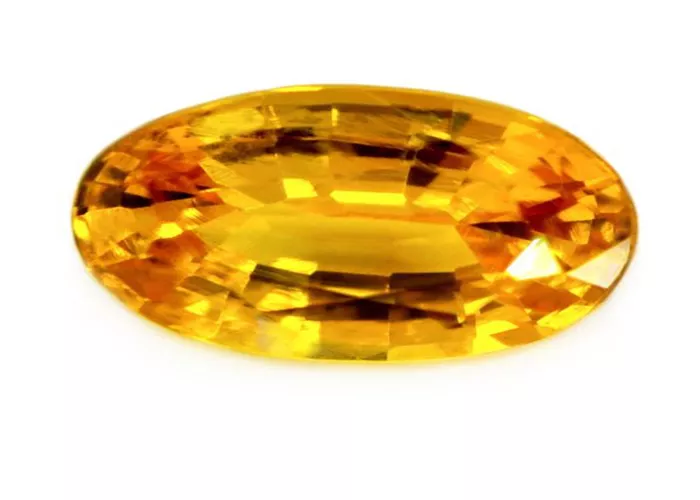Yellow sapphires, known as the “yellow gem-grade corundum,” have been admired for their vibrant hues and unique charm. These gemstones exhibit a wide range of yellow shades, from pale yellow to vivid yellow, golden yellow, honey yellow, and even brownish yellow. With their elegance and mystique, yellow sapphires have captured the hearts of many jewelry enthusiasts. However, determining the authenticity of these gemstones can be challenging. This article aims to provide a detailed, step-by-step guide to identifying genuine yellow sapphires, ensuring you make informed purchases.
Understanding Yellow Sapphire
Yellow sapphires belong to the corundum family, which includes rubies and sapphires of various colors. What sets yellow sapphires apart is their dominant yellow hue, which can range from subtle to intense. These gemstones are typically found in medium to large sizes, and to enhance their color intensity, they are often cut into椭圆形混合刻面琢型 with an enlarged pavilion.
Identifying Genuine Yellow Sapphires
Determining the validity of yellow sapphires involves several steps, from visual inspection to advanced testing. Here’s a comprehensive guide:
1. Visual Inspection
Color and Tone:Yellow sapphires display a range of yellow shades. The most sought-after tones are vivid and intense, with good saturation. A well-colored yellow sapphire should exhibit a uniform color distribution with no visible color zoning.
Clarity and Transparency:Like other corundum gemstones, yellow sapphires can contain internal inclusions such as liquid-like fingerprint inclusions, mineral crystals, and healing cracks. While these inclusions are natural and can vary in appearance, they should not significantly affect the transparency of the gemstone. A highly transparent yellow sapphire with minimal inclusions is generally more valuable.
Cut and Polish:The cut and polish of a yellow sapphire can greatly impact its appearance. A well-cut gemstone will have good symmetry, proportional pavilion and crown angles, and a high degree of polish. This ensures that the gemstone reflects light optimally, enhancing its brilliance and fire.
2. Advanced Testing
Spectroscopy:Spectroscopy is a non-destructive testing method used to determine the color origin of gemstones. By analyzing the absorption spectrum of a yellow sapphire, gemologists can identify the presence of specific chromophores (color-causing elements) and distinguish natural from synthetic or treated gemstones.
Refractometry and Specific Gravity:Refractometry measures the refractive index of a gemstone, while specific gravity measures its density relative to water. These tests help confirm the identity of the gemstone as corundum. Yellow sapphires typically have a refractive index range of 1.762-1.778 and a specific gravity of approximately 4.00.
Thermal Conductivity:Corundum gemstones, including yellow sapphires, exhibit high thermal conductivity. Using a thermal conductivity tester, gemologists can quickly distinguish corundum from other gem materials like glass or synthetic spinel, which have lower thermal conductivity.
UV-Visible Spectroscopy:UV-visible spectroscopy can reveal the presence of trace elements in a gemstone, which can provide clues about its origin and treatment history. For example, certain types of treated yellow sapphires may show characteristic absorption patterns that indicate heating or irradiation treatment.
Hardness Testing:Corundum is one of the hardest minerals on Earth, with a Mohs hardness of 9. A genuine yellow sapphire should be able to scratch a piece of glass without leaving a scratch on its surface. However, this test should be used cautiously as it may damage the gemstone or the glass being tested.
3. Origin and Treatment
Origin:Yellow sapphires are sourced from various locations worldwide, including Sri Lanka, Australia, Myanmar, and Madagascar. Each origin can affect the gemstone’s color, clarity, and overall quality. For example, Sri Lankan yellow sapphires are often praised for their bright and vivid colors, while Australian sapphires may exhibit a more muted, earthy tone.
Treatment:Many yellow sapphires undergo heat treatment to enhance their color and clarity. While heat treatment is a widely accepted practice in the gemstone industry, it should be disclosed to consumers. Untreated natural yellow sapphires are rare and highly valued.
Synthetic yellow sapphires are also available, produced through methods such as the Verneuil process. These gemstones have similar physical properties to natural ones but lack the rarity and unique charm of naturally occurring sapphires.
Common Imposters and How to Avoid Them
Several gemstones can mimic the appearance of yellow sapphires, including yellow topaz, citrine, and even synthetic materials like glass or cubic zirconia. Here’s how to distinguish them:
Yellow Topaz
Yellow topaz is a relatively common gemstone that can be easily distinguished from yellow sapphires by its lower hardness (Mohs 6.5-7) and lower refractive index (1.619-1.633). Topaz also tends to have a more glassy luster compared to the vitreous luster of sapphires.
Citrine
Citrine is a variety of quartz that exhibits a yellow-to-orange color. It has a lower hardness (Mohs 7) and refractive index (1.544-1.553) than yellow sapphires. Citrine’s color is often more uniform and less saturated compared to the more vibrant hues of yellow sapphires.
Synthetic Materials
Synthetic gemstones like glass or cubic zirconia can be made to resemble yellow sapphires but can be easily identified through advanced testing methods such as spectroscopy, refractometry, and thermal conductivity testing.
Conclusion
Determining the validity of yellow sapphires requires a combination of visual inspection, advanced testing, and knowledge of the gemstone’s origin and treatment history. By carefully examining the color, clarity, cut, and polish of a yellow sapphire and utilizing scientific testing methods, gemologists can accurately identify genuine gemstones and distinguish them from imposters.
Related topic:


